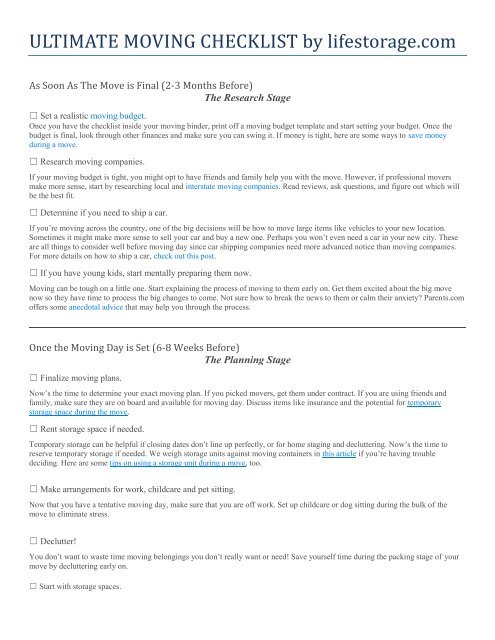ULTIMATE MOVING CHECKLIST by lifestorage
Life is stressful enough. Use this moving checklist to keep you on track of your next home move.
Life is stressful enough. Use this moving checklist to keep you on track of your next home move.
Create successful ePaper yourself
Turn your PDF publications into a flip-book with our unique Google optimized e-Paper software.
<strong>ULTIMATE</strong> <strong>MOVING</strong> <strong>CHECKLIST</strong> <strong>by</strong> <strong>lifestorage</strong>.com<br />
As Soon As The Move is Final (2-3 Months Before)<br />
The Research Stage<br />
☐ Set a realistic moving budget.<br />
Once you have the checklist inside your moving binder, print off a moving budget template and start setting your budget. Once the<br />
budget is final, look through other finances and make sure you can swing it. If money is tight, here are some ways to save money<br />
during a move.<br />
☐ Research moving companies.<br />
If your moving budget is tight, you might opt to have friends and family help you with the move. However, if professional movers<br />
make more sense, start <strong>by</strong> researching local and interstate moving companies. Read reviews, ask questions, and figure out which will<br />
be the best fit.<br />
☐ Determine if you need to ship a car.<br />
If you’re moving across the country, one of the big decisions will be how to move large items like vehicles to your new location.<br />
Sometimes it might make more sense to sell your car and buy a new one. Perhaps you won’t even need a car in your new city. These<br />
are all things to consider well before moving day since car shipping companies need more advanced notice than moving companies.<br />
For more details on how to ship a car, check out this post.<br />
☐ If you have young kids, start mentally preparing them now.<br />
Moving can be tough on a little one. Start explaining the process of moving to them early on. Get them excited about the big move<br />
now so they have time to process the big changes to come. Not sure how to break the news to them or calm their anxiety? Parents.com<br />
offers some anecdotal advice that may help you through the process.<br />
Once the Moving Day is Set (6-8 Weeks Before)<br />
The Planning Stage<br />
☐ Finalize moving plans.<br />
Now’s the time to determine your exact moving plan. If you picked movers, get them under contract. If you are using friends and<br />
family, make sure they are on board and available for moving day. Discuss items like insurance and the potential for temporary<br />
storage space during the move.<br />
☐ Rent storage space if needed.<br />
Temporary storage can be helpful if closing dates don’t line up perfectly, or for home staging and decluttering. Now’s the time to<br />
reserve temporary storage if needed. We weigh storage units against moving containers in this article if you’re having trouble<br />
deciding. Here are some tips on using a storage unit during a move, too.<br />
☐ Make arrangements for work, childcare and pet sitting.<br />
Now that you have a tentative moving day, make sure that you are off work. Set up childcare or dog sitting during the bulk of the<br />
move to eliminate stress.<br />
☐ Declutter!<br />
You don’t want to waste time moving belongings you don’t really want or need! Save yourself time during the packing stage of your<br />
move <strong>by</strong> decluttering early on.<br />
☐ Start with storage spaces.
Storage spaces are where you will find the most items that can be tossed or donated, so start there. These include closets, basements,<br />
attics, garages, storage units and crawl spaces.<br />
☐ Separate items for donation, resale, recycling and trash.<br />
Not sure what to keep and what to toss? The four-box technique can be extremely helpful in making quick decisions, even when it<br />
comes to sentimental items.<br />
☐ Take donation items to a donation center.<br />
☐ Plan a garage sale if you have enough resell items.<br />
This garage sale planning checklist and these garage sale printables may help!<br />
After Movers Are Under Contract (One Month Before)<br />
The Preparation Stage<br />
☐ Print off moving box labels.<br />
Before you start packing, plan moving labels <strong>by</strong> room and item. Use your computer and the biggest box of cheap labels you can find.<br />
Bonus tip: Once a box in a room is packed, place the moving label on the upper right-hand corner on each side of the box. This<br />
location is visible even when boxes are stacked on top. (Hint: Our free moving printables kit comes with moving box labels! Grab<br />
them here.)<br />
☐ Pick up moving boxes.
Take a quick inventory of the items in your home and determine how many moving boxes you’ll need. Purchasing new boxes is ideal<br />
because the cardboard isn’t compromised in any way. Get specific boxes for fragile items and clothing for ease of packing and<br />
moving.<br />
Types of Moving Boxes<br />
☐ Start a moving box inventory.<br />
A moving box inventory is a spreadsheet or list that you can use to track what items are packed in which boxes. We’ve included<br />
inventory sheets in our moving printables kit, but starting your own is simple. Start a new page for each room in your new home.<br />
Simply assign each box you pack with a number. Record that number on your inventory list and jot down notes about what each box<br />
contains. If you need to find something quick on or shortly after moving day, you’ll be able to quickly reference this list! It’ll also<br />
come in handy as you make sure you’ve loaded and unloaded all your boxes on moving day.<br />
☐ Start packing items that aren’t in daily use.<br />
The sooner you start to pack, the less packing will feel like work. To get started, pick a room and pack everything inside that you<br />
won’t realistically need for the next month. Storage spaces again are a great place to start since they typically hold items that aren’t<br />
used frequently. Decor can also be packed up at this point.<br />
Organize the room into sections like clothes, books, accessories, etc. Keep these similar items together. For more packing tips, check<br />
out our post 10 Packing Tips You Need to Know.<br />
☐ Organize important documents and valuable items.<br />
As you’re packing up rooms, remember to keep important papers and valuable items separate. Make a plan for how you will move<br />
things like birth certificates, jewelry and cash. Ideally, these boxes should be kept with you during the move.<br />
☐ Start packing an essentials kit.<br />
Figure out your family’s essentials, which are those things you will need to get <strong>by</strong> in the week during and following the move. The<br />
contents of these boxes will be highly personalized to your family. For instance, most people should include clothing for a week, but<br />
perhaps you also need to add your child’s prized teddy bear. The idea is to start creating a list of the items to include. Keep these<br />
boxes for essentials open and well labeled. You likely won’t finish packing these boxes until the day before you move.<br />
Read Also: What to Pack in a Moving Essentials Kit<br />
☐ Create a list of items to buy for the new place.<br />
Create a list of items you’ll need when you move in. (Moving into your first apartment? This list will help.) Prioritize which things are<br />
the most important to have on hand during your first month in your new home. If this is your first apartment, chances are you’ll need<br />
to add a lot of things to this list.<br />
Once You’re Organized (Three Weeks Before)<br />
The Packing Stage<br />
☐ Protect your furniture for the move.<br />
Furniture that you won’t have to use in the month leading up to the move can be dismantled and prepped at this point. There’s no<br />
sense leaving your guest bedroom furniture or other rarely used items to the last minute. Besides dismantling large pieces, there are<br />
more ways you can protect your furniture while moving. Learn about them here.<br />
☐ Pack dishes.<br />
Usually, clothing and dishes take up the most boxes and take the longest to pack. As such, consider using specific dish pack boxes for<br />
your dishes. Take care to wrap them correctly (and yes, there’s a guide for that!). Now’s the time to stock up on paper goods for<br />
moving week.<br />
☐ Pack out-of-season-clothes.<br />
For clothing, figure out the best method for moving clothes depending on how far you need to travel.
☐ Complete a change of address form.<br />
Visit your local post office or go online to fill out a change of address form. Determine if you need their Premium Forwarding Service.<br />
When Panic Starts to Set In (Two Weeks Before)<br />
The Errand-Running Stage<br />
☐ Update your moving box inventory based on the boxes you’ve packed so far.<br />
☐ Plan meals for the final two weeks.<br />
Now’s the time when grocery shopping should be very intentional. You don’t want to purchase too much food that you’ll ultimately<br />
have to move. Meal plan so you can make use of leftovers. Try to eat as much perishable food from your fridge during these last<br />
couple weeks.<br />
☐ Return library books and items borrowed from neighbors.<br />
☐ Refills prescriptions and purchase travel essentials.<br />
Make sure all your scripts are filled. Also, pick up travel sized items to put in your essentials kit, like contact solution or mouthwash.<br />
This way you can start packing up the rest of the toiletries you use daily.<br />
☐ Tune up vehicles.<br />
Bring your car in for an oil change and inspection. Make sure your registration is up to date. Now is also an excellent time to run your<br />
car through the car wash and clean the inside of your vehicle.<br />
Before Moving Day Sneaks Up On You (One Week Before)<br />
Finalization Stage<br />
☐ Reconfirm moving plans with friends or movers.<br />
Though this might seem unnecessary, sometimes dates and times get lost in translation. Make a final call to confirm the moving date<br />
and time with your movers and helpers.<br />
☐ Transfer school and medical records.<br />
Most times, you’ll have to visit your doctor’s office or school in person to complete the necessary forms to have your information<br />
transferred, which is why you should do this well in advance and not in the height of your move.<br />
☐ Cancel or change ongoing subscriptions and services.<br />
Use this opportunity to save money on things like car insurance, TV, and internet. Shop around for the best deals, cancel your existing<br />
service, or negotiate for the best price.<br />
For a full list of people to notify about a change of address check out this article: Who to Notify When Moving (8 Places to Look)<br />
☐ Complete last-minute packing.<br />
At this point, the bulk of your household items should be packed away in boxes. Start to finalize all that packing. Opt for simple meals<br />
and paper plates so you can get the rest of your kitchen packed. Other items to pack during this time include:<br />
☐ A week’s worth of clothing in suitcases.<br />
☐ Most of the remaining items for your essentials kit.
☐ Prepare appliances for the move.<br />
At this point, task yourself with appliance prep. For instance, empty gas from mowers and other household tools, prep your fridge for<br />
moving, disconnect the gas line from the stove, etc.<br />
☐ Schedule shut off and turn on of utilities.<br />
You don’t want to schedule shut off and turn on of utilities too soon in advance because your moving day could change and then that’s<br />
more phone calls you have to make.<br />
☐ Clean your current home.<br />
Once everything is packed, give your house a thorough cleaning. It’s sometimes necessary and polite to leave your current home in<br />
good shape, which means broom-swept.<br />
When the Big Day Arrives! (On Moving Day)<br />
The Moving Out Stage<br />
☐ Confirm details and keep movers on task.<br />
When the movers arrive, set your intentions for the move, so everyone is on the same page. Plan a rough time to arrive at the new<br />
place and plan a time when everyone will break for lunch. You’ll likely be paying <strong>by</strong> the hour, so it pays to keep movers on schedule.<br />
Use our printable room labels to direct traffic around your new home and follow your moving box inventory to make sure all boxes<br />
have arrived.
☐ Double check the house during the final walkthrough.<br />
After your existing home is empty, do a final walkthrough to make sure nothing has been left behind. Keep tallies and take photos of<br />
any damage that has happened to the home or your items throughout the day.<br />
☐ Pay the movers.<br />
After a final inspection, review your invoice thoroughly and pay the movers. Don’t forget to tip!<br />
☐ Unpack your essentials kit.<br />
Once you’re in the new home, unpack the boxes with your essentials first, then relax!<br />
Before You Unpack<br />
☐ Pop some bubbly! Moving is not easy work.<br />
The Moving In Stage<br />
☐ Think through how you want to organize your home before you unpack.<br />
Moving into a new home is a fresh chance to undo any negative organization habits you had in your last home. Learn how to keep<br />
your home organized and tidy as you unpack, so things don’t need to be moved twice.<br />
Soon After Moving Day<br />
The Settling In Stage<br />
☐ Register car and change license.<br />
If you changed states, don’t forget to update your car information.<br />
☐ Purchase items for your new home.<br />
Earlier you created a list of items you need when you move in. Now’s the time to purchase these items. If you’re on a budget, buy just<br />
what is necessary for the time being. Not everything needs to be furnished right away.
















